The Steelcase Gesture is one of the most popular in the industry, but it’s price point isn’t’ something that everyone can afford. The Amia is another chair in the Steelcase lineup that may be a great option for those not looking to break the bank on their purchase. While the Amia chair costs less, there are a few things you’ll miss out on when compared to a high-end chair like the Gesture. This blog will compare the Amia and Gesture, so you know exactly what you’ll be getting with each chair.
Full Disclaimer: We are an office furniture dealer and sell some of the products we review. To learn more about the products we sell, our review process and why you can trust us, please visit: Why we’re different. Who is BTOD.com and The Learning Center?
Steelcase Gesture vs. Steelcase Amia Links
1. 2025 Price
While these chairs have a lot of similarities, you’ll still notice a price gap. The Steelcase Amia sells from around $820 to the high of $1643 depending on how you configure the chair. In our office, we have an Amia with the fully adjustable arm package, adjustable lumbar support, basic black fabric, and a basic frame, which costs about $899 from the Steelcase store.
(Buy on Amazon) (Buy Refurbished on BTOD)
On the other hand, the Gesture price can rise as steep as $2456 if you get it with all the bells and whistles. Being a more high-end chair, the Gesture has features that the Amia won’t have. In our office, we have a Gesture with a wrapped back and upgraded adjustable lumbar support that costs around $1399.
2. Policies
All of the policies will be the same when ordering from Steelcase, so whether you order the Gesture or Amia, they’ll arrive via FedEx Ground to your door. They feature a 14-day return policy but be sure to keep your original packaging to get it back to them in new condition to prevent any sort of stocking fees. Both chairs will come with a 12-year warranty covering people weighing up to 400 lbs. and 24/7 usage. They will both arrived fully assembled and ready to sit in once you get the chair out of the box, or if you chose to return the chair, you can simply put it back in the box and ship it off without any disassembly.
3. Build Quality

We’ve tested many office chairs here at BTOD.com that have scored a 90 or above on our comfort test. The Amia scored a 90 and the Gesture scored a 94, putting them both near the top of our list. This is because both of these chairs are very well built. All the components are very high-end and function smoothly together. The Steelcase brand is known for making very high-end chairs that often outlast their warranty.

The reason why the Gesture tested higher by four points, is because of the higher-end design and additional technology. Features like the seat slider dial, arm adjustments, and wrapped back set this chair apart from the Amia.
4. Seat Comfort
When we evaluate seat comfort, we allow a large group of employees in our office to test the chair and then rank the comfort from 0 to 100. Once we get that number, we average everyone’s rating to find our final score.
Both of these chairs tested near the top of our list with the Amia receiving a 79 and the Gesture receiving an 81 on seat comfort. Both seats are designed with thinner seat pads that are very firm, but spacious, removing hard edges and giving you room to move around while you sit.
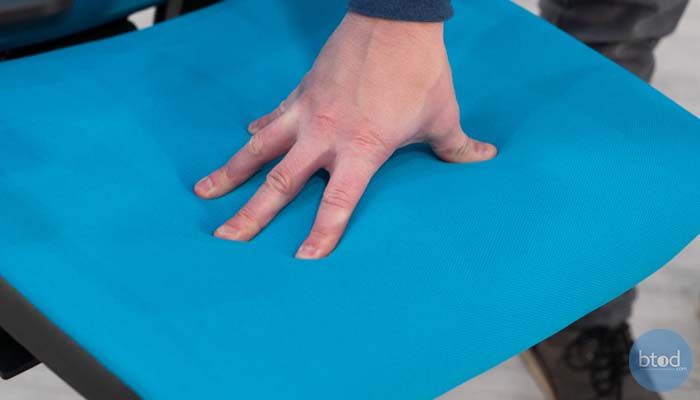
The difference between the two is that the Amia is slightly more padded than the Gesture, making it a bit softer. On the other hand, the advantage that the Gesture has is flexibility in the seat pan, allowing you to move around comfortable while you sit.

5. Back Comfort
Again, both of these chairs tested near the top of our list for back comfort. The Amia scored a 79 and the Gesture scored an 80. These are very similar backrest designs, both featuring Liveback Technology and height adjustable lumbar support.
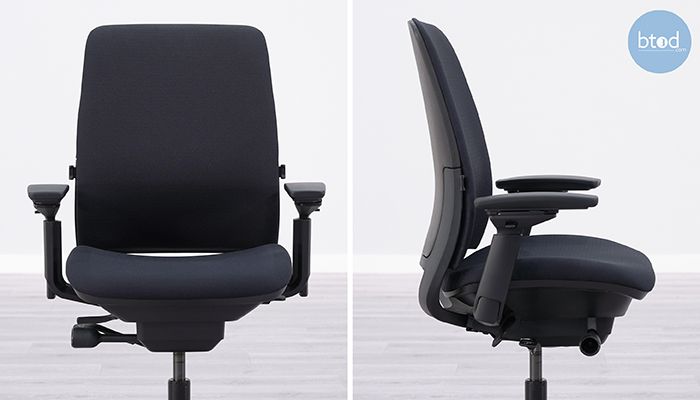
The biggest difference between the two is the flexibility that they offer. Compared to other office chairs, the Amia has top of the line flexibility, but is still lacking in comparison to the Gesture. The Gesture allows for a wider range of movement than the Amia, making it very easy to stay comfortable while seated. The one downside to the Gesture is for those who like to sit completely upright in their chairs for tasking. The flexibility in the back and extra wiggle of the tilt makes it where you have to recline ever so slightly. The Amia on the other hand allows you to sit totally upright.
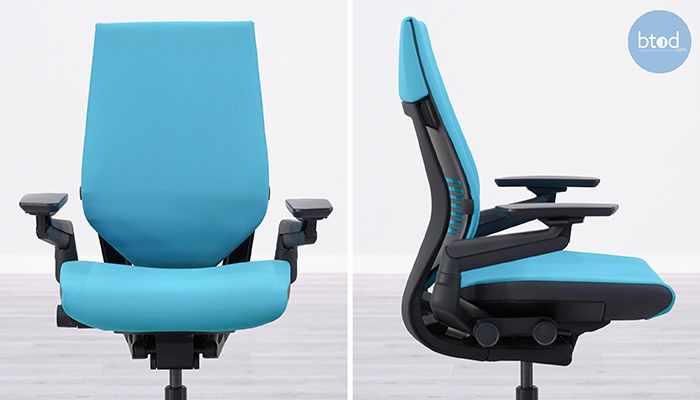
6. Armrest Comfort
Steelcase is known for its high-end armrests on their chairs and the Amia and Gesture do not disappoint. The Amia scored an 82 and the Gesture an 84, putting them both on the top of our list once again. Both chairs feature one of the most adjustable arm packages you’ll find in the business (if you upgrade to the fully adjustable arms on the Amia).
The upgraded fully adjustable arms on the Amia come with height, width, depth, and pivot adjustments with articulation motion.
The cantilever design on the Gesture allows for some of the biggest range of movement we’ve seen on any office chair. If you’re a fan of having your arms in many different positions during the day, this chair may be perfect for you.
Overall, both of these chairs offer some of softest, most comfortable arms, with the widest range of motion and adjustments in the business.
7. Ergonomics
Since our previous list, we’ve changed the way we rate the ergonomics of every chair. We now combine comfort scores with adjustments to get a well-rounded score. This way we don’t have chairs placed at the top of the list that are loaded with adjustments but not comfortable.
Both the Gesture and Amia tested near the top of our ergonomics list with the Amia scoring 81 and Gesture scoring 83. The reason for the difference in scoring is due to slight differences in comfort scores and the Gesture featuring a few more adjustments.
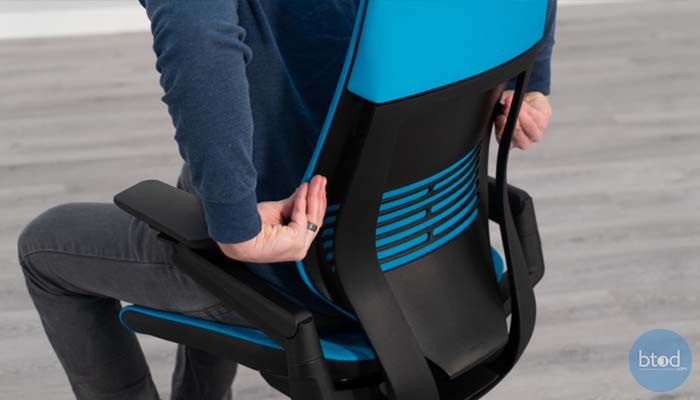
Looking at functionality by itself, both of these chairs are very similar. Both include seat height adjustments with good ranges, seat depth adjustment, height adjustable lumbar support, and tension control.
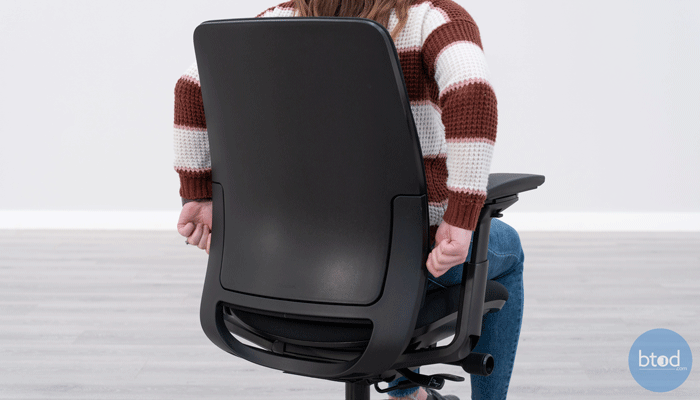
The first major difference we see between these chairs is the tilt lock. The Gesture features four positions of tilt limiter, giving you a lot of flexibility in the range you recline. The Amia doesn’t have tilt limiter options, but it does have an option to lock the chair fully upright in a tilt lock position.
As for other ergonomic adjustments, both chairs come with fantastic arm adjustability that was highly rated amongst users in our office.
Final Thoughts
Both of these options are well-built products with some of the best policies in the industry. The main differences between the two come down to the high-end design and additional add-ons for the Gesture as compared to the standard task look you get from the Amia. When put head-to-head, these chairs are very similar in terms of comfort and adjustments. If you’re someone who doesn’t need the high-end design or tilt-limiter functions, the Amia may be a great alternative to the Gesture. If you’re looking for a high-end chair with all the bells and whistles, the Gesture is going to be the chair for you.
Additional Steelcase Resources
- Steelcase Leap vs. Steelcase Amia: Which is better in 2025?
- My Steelcase Amia Review 1 Year Later (2025)
- Building the Perfect Chair: Unveiling the Lamia Chair
- Steelcase Gesture Office Chair Review for 2025
- Herman Miller Aeron Chair vs Steelcase Gesture in 2025
- Steelcase Leap v2 vs. Gesture Chair: 2025 Comparison







Joe
I would like to buy a refurbished Amia but every time I buy something used or refurbished I end up regretting it. There is no way I could feel confident buying anything refurbished/used from your site but the pricing are tempting.